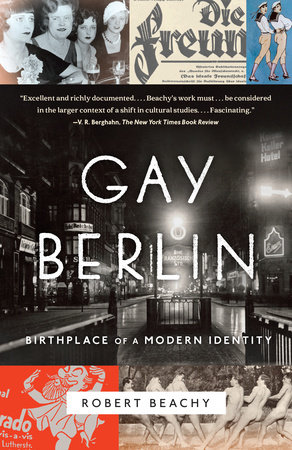From Robert Beachy's Gay Berlin
 |
| Gay Berlin |
Homoeroticism and Anti-Democratic Politics
There were homosexuals within the Nazi movement ... Consider too that the popular Männerbund ideology of the Weimar period helped to assimilate homoeroticism to a nationalist, anti-democratic politics.
[See also Judith (Jack) Halberstam: The Queer Art of Failure (2011) - Chapter 5, "The Killer in Me Is the Killer in You": Homosexuality and Fascism]
Perhaps the best example -- or best known, in any case -- was Ernst Röhm, a decorated veteran of the war, a member of the Freikorps, and an alte Kämpfer ("old fighter") from the Munich beer-hall days of the early Nazi Party. Moreover, Röhm was Hitler's closest friend among the Nazi elite, and the only one with whom he used the informal German address (du as opposed to Sie). In 1930 Röhm, at Hitler's behest, became leader of the SA [Sturmabteilung], the party's brownshirted militia. In the summer of 1931, however, Röhm was forced to defend himself in two highly publicized trials held in Munich. He had been caught with male prostitutes and was accused of violating the anti-sodomy statute. Through the course of the trials the prosecution managed to produce some of Röhm's private letters and correspondence. The trials also established that Röhm had actually joined the largest of the three homosexual rights organizations the Human Rights League, in the 1920s. Despite Röhm's scandals, Hitler refused to sack him, and claimed blithely that Röhm's personal life was a private affair.
Campaign for a Clean Reich - February 1933
Of course, the SA provided boots on the ground for the Nazi movement, and after Hitler came to power, they were largely responsible for shoring up Nazi control, at least in the first eighteen months of the regime's rule. The fact that a high-ranking Nazi -- at this point Röhm was arguably the second most powerful man in the Third Reich -- was openly homosexual did not shield the institute [Institut für Sexualwissenschaf, Institute for Sexual Research]. Nor did it prevent the repression of the homosexual rights movement. The Nazis’ "Campaign for a Clean Reich," inaugurated in February 1933, shut down Berlin's homosexual press and closed some fifteen of the most prominent bars. The last publications appeared in March. By summer, the three homosexual rights organizations, including the SHC [Wissenschaftlich-humanitäres Komitee, Scientific Humanitarian Committee], had destroyed their membership lists and begun the process of disbanding. Yet these actions were less a singling out of homosexuals than an extension of the more general "coordination," or Gleichschaltung, of German civil society. Most non-Nazi groups during the first months (or in some cases years) of Nazi rule, including those on the right, experienced similar repression or were forced to merge with Nazi organizations. Despite the Gleichschaltung, the vast majority of the estimated eighty to one hundred gay and lesbian bars and clubs in Berlin remained open well into 1935. At this stage the Nazis targeted homosexual men and women only if they were Jewish or leftists.
Night of the Long Knives - June 30 - July 2, 1934
The fate of Röhm changed all of this, though not because his presence somehow shielded homosexuals, but rather because his murder allowed Heinrich Himmler -- Röhm's arch-nemesis among the Nazi elite – free reign to implement a more systematic repression. Röhm’s career (and life) came to an abrupt end on July 2, 1934, in the purge of the SA leadership known as the Night of the Long Knives. It was widely rumored that Röhm and many of his associates were discovered in bed with young boys or with each other. The number of those killed is fairly murky, but estimates now hover around eighty-five. Most of the known victims were SA leaders or close Röhm associates. Some had no ties at all to the SA, however, and were simply targeted opportunistically. In a radio address delivered on July 2, Joseph Goebbels, the Nazi minister of propaganda, explained that Hitler had preempted a putsch attempt planned by Röhm and his henchmen. This was a fiction. The real reason was Hitler's need to appease the military, which feared Röhm and his militia. Once Röhm was gone, Hitler was finally able to command the loyalty of the German military and complete the consolidation of his power. Of course, subsequent Nazi propaganda also emphasized Röhm's homosexuality -- in addition to his alleged perfidy -- and the Nazis commitment to traditional morality.
An Ideology of Homophobia
Röhm's elimination cleared the way for a more systematic persecution of homosexuals. This campaign was led by Himmler, head of the SS and the ideologue of Nazi homophobia. In 1935 Himmler championed a new, draconian anti-sodomy statute, which criminalized all erotic contact between men. One year later Himmler established the Reich Office to Combat Homosexuality and Abortion. Nazi officials now had the tools to arrest and imprison large numbers of homosexual men on the flimsiest of evidence. This policing reflected Nazi views that male homosexuality was a contagious perversion and that homosexual conduct, like disease, might be cured. The persecution that followed had two major objectives. Nazi officials hoped to curb and redirect the majority of those who had fallen into homosexual "vice with a variety of treatments, and, if necessary, incarceration. Of these, a small minority of "incorrigibles" -- those with "hereditary" conditions who were deemed responsible for "seducing" others would be exterminated to stop the spread of "infection." During the Third Reich more than 100,000 German men were charged under Paragraph 175, and of these an estimated 5,000 to 15,000 perished in prisons and camps. As Dagmar Herzog has argued, "Many Nazi 'experts' advanced a social constructionist view of sexuality that sexual identity was variable and vulnerable." This was in part an anti-Semitic rebuke of the theories of the "Jewish" Hirschfeld and "his" SHC, but it also persisted long after 1945.
No comments:
Post a Comment